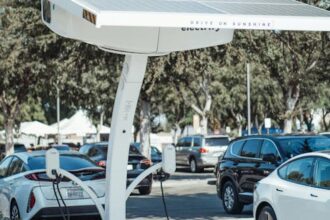Imagine a world where your smartphone connects to the internet not through a cell tower—but through a satellite whizzing 550 kilometers above Earth. Where rockets land themselves after launch, refuel in orbit, and head to the Moon—all in the same week. Where nations and billionaires alike race not just for prestige, but for trillion-dollar orbital economies.
Welcome to Space Tech in 2025.
What was once the exclusive domain of superpowers and government agencies has exploded into a global, commercial, AI-powered, investor-fueled revolution. In 2025, space is no longer “out there.” It’s infrastructure. It’s logistics. It’s broadband, Earth observation, national security, and even tourism.
This article explores the seismic shifts underway in satellites, rockets, and the intensifying New Space Race—backed by 2025 data, real-world case studies, expert forecasts, and strategic insights designed to help businesses, investors, policymakers, and curious minds understand where humanity is headed—above the atmosphere.
Whether you’re tracking investment trends, evaluating supply chain risks, or simply fascinated by humanity’s next giant leap, this is your definitive guide to Space Tech in 2025.
Why 2025 Is the Inflection Point for Space Tech
2025 isn’t just another year in the calendar of spaceflight. It’s the convergence point of technological maturity, regulatory frameworks, private capital, and geopolitical urgency.
Consider this:
- The global space economy is projected to reach $1.8 trillion by 2035 (up from $630 billion in 2023), according to Morgan Stanley’s 2024 Space Report.
- Over 5,000 active satellites now orbit Earth—up from just 2,000 in 2020. By 2025, that number will exceed 8,000.
- Reusable rocket technology has slashed launch costs by over 70% since 2015, enabling weekly, even daily, access to space.
- AI is now embedded in satellite operations, mission planning, and autonomous spacecraft—reducing human error and enabling real-time decision-making.
“2025 is when space stops being a novelty and becomes a utility,” says Dr. Laura Forczyk, founder of space consulting firm Astralytical. “We’re moving from ‘Can we do it?’ to ‘How do we scale it sustainably?’”
The implications? Massive.
From real-time crop monitoring for farmers in Kenya to ultra-secure quantum communications for NATO, space tech in 2025 touches every sector. And the players? No longer just NASA and Roscosmos. Now it’s SpaceX, Rocket Lab, Relativity Space, ISRO, CNSA, ESA, and hundreds of startups from Lagos to Luxembourg.
Satellites in 2025: Smaller, Smarter, and Everywhere
If rockets are the delivery trucks of space, satellites are the factories, cameras, routers, and sensors that make space useful. In 2025, satellites are undergoing a radical transformation.
Miniaturization: The Rise of SmallSats and CubeSats
Gone are the days of billion-dollar, bus-sized satellites taking a decade to build. Today’s satellites are smaller, cheaper, and faster to deploy.
By 2025:
- CubeSats (10x10x10 cm modules) will account for over 60% of all satellite deployments.
- The average satellite mass has dropped from 3,000 kg in 2000 to under 200 kg in 2025.
- Manufacturing lead times have shrunk from 5 years to under 12 months.
Why does this matter?
Smaller satellites mean:
- Faster innovation cycles (think “Agile in orbit”)
- Lower financial risk per launch
- Constellations instead of single birds—enabling global coverage
Case in point: Planet Labs, a San Francisco-based company, operates over 200 Dove satellites (each the size of a shoebox) that image the entire Earth’s landmass daily. In 2025, they’re adding hyperspectral sensors to detect crop health, methane leaks, and illegal mining—in near real-time.
AI-Powered Satellites: From Dumb Sensors to Smart Observers
In 2025, satellites don’t just collect data—they analyze it.
Onboard AI processors now enable satellites to:
- Filter out cloud cover before transmitting images
- Detect wildfires or floods and alert authorities autonomously
- Prioritize high-value targets (e.g., military movements, shipping lanes)
- Self-diagnose malfunctions and reroute tasks to other satellites
“Edge computing in space is no longer science fiction,” says Dr. Moriba Jah, space environmentalist and professor at the University of Texas. “AI allows us to process petabytes of data in orbit—saving bandwidth, time, and money.”
Take Umbra Labs: their 2025 SAR (Synthetic Aperture Radar) satellites use machine learning to generate high-res radar images through clouds, smoke, or darkness—crucial for disaster response and defense.
Constellations Dominate: Starlink, OneWeb, Kuiper, and Beyond
The biggest story in satellites? Mega-constellations.
By mid-2025:
- Starlink (SpaceX) will operate over 5,000 satellites, providing broadband to 3+ million users across 75 countries.
- Amazon’s Project Kuiper will launch its first 500 operational satellites, targeting rural broadband and enterprise IoT.
- China’s GuoWang constellation will deploy 13,000 satellites by 2030—with 2,000 expected by end of 2025.
These aren’t just internet projects. They’re strategic infrastructure.
Starlink proved its value in Ukraine, providing battlefield comms when terrestrial networks failed. In 2025, militaries worldwide are integrating commercial constellations into their C4ISR (Command, Control, Communications, Computers, Intelligence, Surveillance, Reconnaissance) systems.
But challenges remain:
- Orbital congestion: Risk of collisions increases with every launch.
- Light pollution: Astronomers report degraded observations due to satellite trails.
- Regulatory gaps: Who governs space traffic? The FCC? The UN? No global system exists yet.
Enter the Space Sustainability Rating (SSR)—a 2025 initiative led by the World Economic Forum and ESA to score satellites on debris mitigation, collision avoidance, and end-of-life plans. Companies scoring poorly may face insurance hikes or launch restrictions.
Earth Observation (EO) Goes Mainstream
Forget Google Earth. In 2025, Earth Observation is real-time, actionable, and monetizable.
Industries leveraging EO data:
- Agriculture: Crop yield prediction, soil moisture mapping, pest detection
- Insurance: Post-disaster damage assessment within hours
- Finance: Monitoring oil tank levels, port activity, retail foot traffic for hedge funds
- Climate: Tracking CO2 plumes, deforestation, glacier melt with centimeter precision
Capella Space, ICEYE, and Synspective are leading the SAR revolution—seeing through weather and darkness. Meanwhile, startups like Orbital Sidekick use hyperspectral imaging to detect methane emissions from oil fields—with accuracy down to 10 meters.
“EO is becoming like weather data—ubiquitous, essential, and embedded in enterprise workflows,” says Caroline Vasko, CEO of space analytics firm SkyWatch.
Rockets in 2025: Reusability, Refueling, and Rapid Launch
If satellites are the “what,” rockets are the “how.” And in 2025, rocket tech is evolving faster than ever.
Full Reusability Becomes Standard
SpaceX’s Falcon 9 proved reusability was possible. In 2025, it’s becoming the norm.
Key developments:
- SpaceX’s Falcon 9 Block 5 boosters now fly 20+ times—some nearing 30 flights.
- Blue Origin’s New Glenn enters service in Q3 2025, featuring a reusable first stage and 45-ton payload capacity.
- Relativity Space’s Terran R—a fully reusable, 3D-printed rocket—aims for first launch in late 2025.
Reusability slashes costs:
- Falcon 9 launch: ~$2,700/kg (vs. $20,000/kg for expendable rockets in 2010)
- Industry-wide target for 2025: under $1,500/kg to LEO
“Reusability isn’t just about cost—it’s about cadence,” says Tim Ellis, CEO of Relativity Space. “We’re moving from ‘launch campaigns’ to ‘launch operations’—like airlines, not expeditions.”
In-Orbit Refueling: The Game Changer
The next frontier? Refueling rockets in space.
Why it matters:
- Enables missions to the Moon, Mars, and beyond without massive launch vehicles
- Allows satellites to extend lifespan by decades
- Creates a new orbital logistics economy
In 2025, two milestones loom:
- Northrop Grumman’s Mission Extension Vehicle (MEV) will dock with its 5th client satellite, proving life-extension services.
- Orbit Fab and Impulse Space will demonstrate cryogenic fuel transfer between two spacecraft in LEO—funded by DARPA’s DRACO program.
“In-orbit servicing is the next trillion-dollar market,” says Jeremy Schiel, co-founder of Orbit Fab. “We’re building the gas stations of space.”
Small Launchers Carve Their Niche
While SpaceX dominates heavy lift, small launchers serve a critical role: dedicated rides for small payloads.
Top players in 2025:
- Rocket Lab – Electron (300kg to LEO), with reusable first stage recovery
- Firefly Aerospace – Alpha (1,000kg), targeting responsive defense launches
- Astra (restructuring) – Rocket 4 aims for ultra-low-cost, high-cadence launches
- India’s Skyroot and China’s iSpace – Emerging Asian challengers
Use cases:
- Replacing a single failed satellite without waiting for a rideshare
- Launching classified payloads on short notice
- Testing new tech in orbit quickly
Rocket Lab’s 2025 Neutron rocket (8-ton payload, reusable) aims to bridge the gap between small and medium lift—potentially disrupting SpaceX’s rideshare dominance.
Nuclear Thermal Propulsion (NTP) Takes First Steps
For deep space, chemical rockets won’t cut it. Enter Nuclear Thermal Propulsion.
In 2025:
- NASA and DARPA will ground-test the DRACO (Demonstration Rocket for Agile Cislunar Operations) engine.
- Target: 2x the efficiency of chemical rockets, enabling 45-day Mars transits (vs. 7 months).
- Lockheed Martin and BWX Technologies are leading the build.
“NTP isn’t sci-fi—it’s scheduled,” says Tabitha Dodson, DARPA program manager. “By 2027, we fly. By 2030, it’s operational.”
While not launching in 2025, the groundwork laid this year will define the next era of interplanetary travel.
The New Space Race: Geopolitics, Commerce, and the Battle for Orbital Dominance
The original Space Race (1957–1975) was a Cold War duel between the U.S. and USSR. The New Space Race? Far more complex.
In 2025, it’s a multi-polar contest involving:
- Nations (U.S., China, India, EU, UAE, Japan)
- Corporations (SpaceX, Blue Origin, Boeing, CASC, Relativity)
- Investors ($12B+ poured into space startups in 2024 alone)
- Startups (over 1,500 globally, per Space Capital)
Let’s break it down.
United States: Innovation Engine, Regulatory Lag
The U.S. leads in private investment, launch cadence, and tech innovation.
2025 Highlights:
- SpaceX targets 150+ launches (Falcon 9/Heavy + Starship test flights)
- NASA’s Artemis III aims for crewed lunar landing (delayed from 2024, likely late 2025 or 2026)
- Space Force expands its orbital warfare capabilities—tracking threats, testing defensive systems
But regulatory bottlenecks persist:
- FAA licensing delays average 6–9 months
- FCC spectrum allocation lags behind demand
- Export controls (ITAR) stifle international collaboration
“We’re winning the race but tripping over our own red tape,” says Carissa Christensen, CEO of BryceTech.
China: The Silent Accelerator
China doesn’t talk much—but it acts decisively.
2025 Milestones:
- Completion of Tiangong Space Station expansion
- First crewed lunar landing test (uncrewed in 2024, crewed target 2025–2026)
- Deployment of GuoWang broadband constellation (Phase 1: 1,300 sats)
- Reusable rocket tests by CASC and private firms (iSpace, Galactic Energy)
China’s strategy: state-directed, long-term, and vertically integrated.
According to the Center for Strategic and International Studies (CSIS), China spent $12 billion on space in 2024—second only to the U.S.—with heavy focus on military-civil fusion.
“China sees space as critical infrastructure—like 5G or semiconductors,” says Dr. Namrata Goswami, space policy expert. “They’re playing a 50-year game.”
India, Europe, and the Rising Challengers
India (ISRO):
- Chandrayaan-4 lunar sample return mission (2025–2026)
- Human spaceflight (Gaganyaan) delayed to 2025
- Privatization push: IN-SPACe licensing 50+ startups in 2024
Europe (ESA):
- Vega-C returns to flight after 2022 failure
- Ariane 6 debuts in mid-2025—critical for EU strategic autonomy
- EU Space Law passed in 2024 mandates debris mitigation and cybersecurity
UAE: Martian ambitions with “Mars 2117” program; 2025 lunar rover mission (Rashid 2) with Japan’s ispace.
Japan (JAXA): Lunar Gateway contributions, asteroid sample returns, and commercial partnerships with startups.
The Private Sector: Where the Real Innovation Lives
While nations set policy, private companies drive progress.
2025’s Top Private Space Companies:
| Company | Focus | 2025 Milestone |
|---|---|---|
| SpaceX | Launch, Starlink, Starship | Starship orbital refueling demo |
| Blue Origin | New Glenn, Orbital Reef | First New Glenn launch, ISS module contract |
| Relativity Space | 3D-printed rockets | Terran R debut, reusability test |
| Sierra Space | Space stations, Dream Chaser | First Dream Chaser cargo flight to ISS |
| Axiom Space | Commercial space stations | Axiom Station module launch |
VC funding remains strong: Space Capital reports $42B invested since 2015, with 2024 seeing $12.3B across 275 deals.
“The barrier to orbit is collapsing,” says Chad Anderson, Managing Partner at Space Capital. “We’re seeing SaaS models, data marketplaces, and space-as-a-service emerge.”
Case Study 1: How Starlink Changed the Game in Ukraine—and What Comes Next
When Russia invaded Ukraine in February 2022, Ukraine’s terrestrial comms infrastructure collapsed. Within 48 hours, SpaceX activated Starlink terminals across the country.
By 2025:
- Over 45,000 Starlink terminals operate in Ukraine
- Used by military, hospitals, schools, and government
- Enabled drone warfare, battlefield coordination, and civilian resilience
Impact:
- Proved commercial space systems can be decisive in modern warfare
- Forced NATO to integrate Starlink into defense planning
- Sparked global demand for sovereign alternatives (e.g., Europe’s IRIS², China’s GuoWang)
“Starlink didn’t just provide internet—it provided sovereignty,” says Mykhailo Fedorov, Ukraine’s Minister of Digital Transformation.
In 2025, SpaceX is testing Starshield—a military-grade version with enhanced encryption, anti-jamming, and dedicated beams for DoD and Five Eyes allies.
Case Study 2: India’s Rise Through Privatization and Low-Cost Innovation
India’s space story in 2025 is one of quiet disruption.
ISRO’s achievements:
- Chandrayaan-3: First nation to land near lunar south pole (2023)
- Aditya-L1: Solar observatory launched in 2024
- SSLV: Small Satellite Launch Vehicle for dedicated microsat launches
But the real story? Privatization.
In 2024, India’s IN-SPACe (Indian National Space Promotion and Authorization Center) licensed over 50 private space startups. Key players:
- Skyroot Aerospace: Vikram rockets, targeting $3M per launch
- Agnikul Cosmos: 3D-printed engines, mobile launch pad
- Dhruva Space: Satellite platforms and ground stations
Result? India’s space economy projected to grow from $9B in 2023 to $44B by 2033 (EY Report 2024).
“India isn’t trying to beat SpaceX on cost. It’s creating an ecosystem,” says S. Somanath, Chairman of ISRO. “Our startups can serve ASEAN, Africa, and Latin America better than anyone.”
Emerging Trends in Space Tech for 2025
AI and Machine Learning: The Invisible Backbone
AI is now embedded at every layer:
- Launch: Autonomous countdowns, anomaly detection
- Orbit: Collision avoidance, task scheduling
- Ground: Data processing, customer analytics
Startups like Orbital Insight and Tomorrow.io use AI to turn satellite imagery into predictive business intelligence—e.g., forecasting retail sales based on parking lot fullness.
Quantum Communications: Unhackable Links from Space
China’s Micius satellite proved quantum key distribution (QKD) from orbit in 2017. In 2025, the EU and U.S. are catching up.
- ESA’s Eagle-1 satellite (launch 2025) will test QKD for secure EU government comms
- U.S. National Quantum Initiative funds space-based quantum networks
- Target: Ultra-secure links for finance, defense, critical infrastructure
Space Manufacturing: Factories in Orbit
Why launch everything from Earth? In 2025, orbital manufacturing takes its first steps.
- Varda Space Industries: Returning capsules with pharmaceuticals crystallized in microgravity
- Redwire: 3D printing structures on ISS; testing fiber optics production
- Goal: Higher purity, unique alloys, and bioprinting impossible on Earth
“Microgravity isn’t a lab curiosity—it’s a production advantage,” says Will Bruey, CEO of Varda.
Debris Removal: Cleaning Up Our Orbital Backyard
With over 36,500 tracked debris objects (ESA, 2024), cleanup is urgent.
2025 missions:
- ClearSpace-1 (ESA/Swiss): First active debris removal—targeting a 112kg Vespa adapter
- Astroscale (Japan): ELSA-d and ADRAS-J missions testing capture and inspection
- Private insurers now require debris mitigation plans for satellite policies
Challenges and Risks Facing Space Tech in 2025
Space Debris and Kessler Syndrome
The nightmare scenario: a cascade of collisions creating an impassable debris field in LEO.
In 2025:
- LEO hosts over 9,000 trackable objects (satellites + debris)
- Average of 3–5 “conjunction alerts” per satellite per day
- No binding international treaty for debris removal
Solutions being tested: lasers, nets, harpoons, and tethers. But funding and liability remain unresolved.
Regulatory Fragmentation
Who governs space?
- U.S.: FAA (launch), FCC (spectrum), NOAA (remote sensing)
- EU: Single Market for Space (2024), but national agencies still dominate
- UN: Outer Space Treaty (1967) is outdated; no enforcement mechanism
Result: Legal gray zones, especially for asteroid mining, on-orbit servicing, and lunar property rights.
Supply Chain and Talent Bottlenecks
Despite growth, the industry faces:
- Shortage of aerospace engineers (U.S. Bureau of Labor Statistics projects 8% growth by 2032, but demand is higher)
- Dependency on rare earth metals and radiation-hardened chips
- Launch pad congestion—Cape Canaveral, Vandenberg, and SaxaVord (Scotland) booked solid into 2026
Geopolitical Tensions and Weaponization
Space is now a warfighting domain.
- U.S. Space Force tracking 100+ “counterspace” tests by China/Russia since 2020
- Anti-satellite (ASAT) weapons banned by UN resolution (2023)—but not enforced
- GPS jamming and spoofing now routine in conflict zones
“Deterrence in space is harder than on Earth,” says Dr. Bleddyn Bowen, space security expert at University of Leicester. “There’s no hiding. Every move is visible.”
Investment Landscape: Where the Money Is Flowing in 2025
According to Space Capital’s 2025 Q1 Report:
- Infrastructure (launch, ground stations, satellites): 45% of funding
- Downstream Applications (EO analytics, comms, navigation): 35%
- Enabling Tech (AI, robotics, materials): 20%
Top VC firms: Space Capital, Seraphim Capital, Type 1 Ventures, Airbus Ventures.
Notable 2024–2025 deals:
- Relativity Space: $500M Series E (Terran R development)
- Orbit Fab: $52M Series B (orbital refueling)
- HawkEye 360: $145M Series D (RF geolocation satellites)
“The smart money is moving from hardware to data and services,” says Emily Calandrelli, space investor and TV host. “Own the pipe? Good. Own the insights from the pipe? Better.”
Future Outlook: What’s Next After 2025?
Looking beyond 2025, the roadmap is clear:
- 2026–2027: First commercial space stations (Axiom, Orbital Reef), Starship lunar missions
- 2028–2030: Permanent lunar base (Artemis), Mars sample return, in-orbit manufacturing scale-up
- 2030+: Cislunar economy, asteroid prospecting, space tourism normalization
Key technologies to watch:
- Space-based solar power (Japan’s Oshima Island demo in 2025)
- Autonomous satellite swarms (DARPA’s Blackjack program)
- Bioprinting organs in microgravity (Redwire, Varda collaborations)
“We’re not just going to space—we’re learning to live there,” says Dr. Sian Proctor, geoscientist and Inspiration4 astronaut.
Space Tech in 2025 Is the Foundation for Our Off-World Future
Space Tech in 2025 isn’t about flashy rocket launches or billionaire joyrides. It’s about infrastructure. It’s about resilience. It’s about extending human capability beyond our atmosphere—permanently.
From AI-guided satellites monitoring climate change, to reusable rockets slashing the cost of access, to nations and corporations racing to claim strategic orbital real estate—the developments of 2025 will echo for decades.
Yes, challenges remain: debris, regulation, talent gaps, and geopolitical friction. But the momentum is unstoppable. The tools are proven. The market is real.
As we stand at this inflection point, one truth is clear: space is no longer the final frontier. It’s the next marketplace. The next battlefield. The next home.
Call to Action: Whether you’re an investor, entrepreneur, student, or policymaker—now is the time to engage. Subscribe to space industry reports. Attend conferences like SATELLITE 2025 or Paris Space Week. Support STEM education. The next era of human progress is being written—in orbit.
Space Tech in 2025 isn’t coming. It’s here.
FAQ: Space Tech in 2025
1. What is the most significant advancement in space tech expected in 2025?
The most significant advancement is the maturation of in-orbit servicing and refueling. Companies like Orbit Fab and Northrop Grumman will demonstrate the ability to refuel and repair satellites in space—extending their lifespan and enabling deep-space missions without massive rockets. This creates an entirely new orbital economy and reduces space debris.
2. How many satellites will be in orbit by the end of 2025?
According to Euroconsult’s 2024 forecast, over 8,000 active satellites will be in orbit by end of 2025—up from 5,000 in early 2024. The majority will be smallsats in LEO constellations (Starlink, Kuiper, GuoWang). This rapid growth intensifies concerns about space traffic management and light pollution.
3. Is space tourism still happening in 2025?
Yes, but scaled back. After the boom of 2021–2022, 2025 sees more regulated, safety-focused tourism. Blue Origin resumes New Shepard flights after 2022 grounding. SpaceX flies 2–3 private missions (e.g., Polaris, dearMoon). Virgin Galactic targets monthly suborbital flights. Prices remain high ($450K+), but operational cadence improves.
4. What role does AI play in space tech in 2025?
AI is now mission-critical. It’s used for:
- Autonomous satellite operations and collision avoidance
- Real-time analysis of Earth observation data (e.g., detecting wildfires, crop stress)
- Predictive maintenance for launch vehicles
- Optimizing ground station scheduling and data downlink
Startups like Orbital Insight and Pixxel embed AI directly into their analytics platforms, turning raw pixels into business decisions.
5. How is the New Space Race different from the Cold War Space Race?
The original Space Race (1957–1975) was a binary, state-driven competition focused on prestige and ideology (U.S. vs. USSR). The New Space Race is multi-polar, commercially driven, and economically motivated. It involves dozens of nations, hundreds of private companies, and trillions in projected market value. Success is measured not just by flags on the Moon—but by market share, data dominance, and orbital infrastructure control.
6. What are the biggest risks to the space industry in 2025?
Top risks include:
- Space debris collisions triggering Kessler Syndrome
- Geopolitical conflict extending to orbital warfare (jamming, ASATs)
- Regulatory delays stifling innovation (especially in U.S. and EU)
- Supply chain bottlenecks for critical components (radiation-hardened chips, helium)
- Talent shortage as demand outpaces qualified aerospace engineers
Proactive mitigation—through international cooperation, AI-driven traffic management, and workforce development—is critical.
7. Can individuals invest in space tech companies in 2025?
Yes. Options include:
- Public stocks: SpaceX (via secondary markets), Rocket Lab (RKLB), AST SpaceMobile (ASTS), Redwire (RDW)
- ETFs: ARKX (ARK Space Exploration), UFO (Procure Space ETF)
- VC funds: Seraphim Space, Type 1 Ventures (accredited investors)
- Crowdfunding: Platforms like StartEngine feature early-stage space startups
Due diligence is essential—many space companies are pre-revenue and high-risk.
References & Citations:
- Morgan Stanley Research: “The Space Economy: $1.8 Trillion by 2035” (2024)
- Space Capital: “2025 Global Space Investment Report”
- European Space Agency (ESA): Space Debris Environment Report (2024)
- CSIS: “China’s Space Program: A Strategic Assessment” (2024)
- NASA: Artemis Program Status (2025 Update)
- UNOOSA: Status of Outer Space Treaties (2025)
- BryceTech: “Launch Vehicle Reusability and Cost Analysis” (2024)
- EY India: “The Future of India’s Space Economy” (2024)








